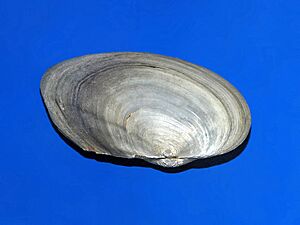Pyganodon cataracta facts for kids
Quick facts for kids Pyganodon cataracta |
|
|---|---|
 |
|
| The pearly interior of a valve of Pyganodon cataracta at the Museo Civico di Storia Naturale di Milano | |
| Conservation status | |
| Scientific classification | |
| Genus: |
Pyganodon
|
| Species: |
cataracta
|
| Synonyms | |
|
List
Anodonta cataracta Say, 1817
Anodonta cataracta subsp. cataracta Say, 1817 Anodonta cataracta subsp. marginata Say, 1817 Anodonta marginata Say, 1817 Anodonta atra Rafinesque, 1820 Anodonta cuneata Rafinesque, 1820 Anodonta digonota Rafinesque, 1831 Anodonta teres Conrad, 1834 Anodonta excurvata DeKay, 1843 Anodonta virgulata Lea, 1857 Anodonta dariensis Lea, 1858 Anodonta williamsii Lea, 1862 Anodonta tryonii Lea, 1862 Anodonta doliaris Lea, 1863 Pyganodon marginata (Say, 1817) |
|
Pyganodon cataracta, also known as the eastern floater, is a type of large freshwater mussel. It is an aquatic bivalve mollusc that lives in rivers and lakes. Mussels are fascinating creatures that help keep our waters clean.
Contents
What is an Eastern Floater?
The eastern floater is a kind of mussel that belongs to a group called Unionidae, often known as river mussels. It used to be called Anodonta cataracta, but scientists have changed its name to Pyganodon cataracta. This happens sometimes when new information about animals is discovered.
These mussels can grow quite large, usually between 10–15 centimetres (3.9–5.9 in) (about 4 to 6 inches) long. Imagine a mussel as long as your hand! They have two shells, called valves, that protect their soft bodies inside. The inside of their shells can be very pretty, often with a pearly shine.
Different Types of Eastern Floaters
Just like there can be different types of dogs, there are also slightly different types of eastern floaters. Scientists call these "subspecies." The two main subspecies are:
- Pyganodon cataracta subsp. cataracta
- Pyganodon cataracta subsp. marginata
These subspecies are very similar but might have small differences in their shells or where they live.
Where Do Eastern Floaters Live?
Eastern floaters live in freshwater habitats, which means they are found in rivers, ponds, and small lakes. You can find them along the Atlantic coast of North America, from Alabama all the way up to parts of Canada.
They prefer places where the bottom of the water is soft, like mud or sand. They often bury themselves partly in the bottom, using their strong foot to move around or dig in.
Why Are Mussels Important?
Mussels like the eastern floater play a very important role in their habitats. They are like natural filters for the water! They draw in water and filter out tiny bits of food, like algae and other small particles. This process helps to clean the water, making it clearer and healthier for other animals and plants.
Because they filter so much water, mussels are often used as indicators of water quality. If there are lots of healthy mussels in a river, it usually means the water is clean. If mussels are struggling, it can be a sign that the water is polluted.
Life Cycle of a Freshwater Mussel
The life cycle of freshwater mussels is quite unique. Unlike many other animals, they need fish to help their babies grow up!
- Larvae: Female mussels release tiny larvae, called glochidia, into the water.
- Hitching a Ride: These glochidia must attach themselves to the gills or fins of a fish. They don't hurt the fish much, but they use the fish as a temporary host.
- Growing Up: While attached to the fish, the glochidia transform into tiny juvenile mussels.
- Dropping Off: Once they are developed enough, the young mussels drop off the fish and settle onto the bottom of the river or lake.
- Adults: They then grow into adult mussels, ready to filter water and start the cycle all over again.
This amazing partnership with fish helps mussels spread to new areas and ensures their survival.


